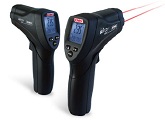September Newsletter 2011 - Non-contact (IR) thermometers and testing food temperature in trasnport. Also, see you at the York Peninsula Field Days!
| September Newsletter 2011 - Non-contact (IR) thermometers and testing food temperature in trasnport. Also, see you at the York Peninsula Field Days! September is here and spring has certainly sprung in these parts. In this month’s newsletter we take an in depth look at infra-red (IR) thermometers, we explain the principles behind how they work and why you would choose to use one over a conventional probe thermometer. We also take a look at how IR thermometers are an invaluable tool in food transport and safety. Off the back of our visit to Sheepvention last month, we are excited to be exhibiting at the York Peninsular Field Days in Paskeville, SA on the 27th, 28th and 29th of September. It will be great to meet with a number of our country SA customers and talk about their instrumentation needs. We will have a number of products for sale including: Weather Stations, Grain/ Hay and Soil Moisture Meters, Temperature Meters, just to name a few. If you are at the Field Days, pop-in and say G’day, we will be in the Larwood Pavilion (Site 3) and would love to meet you face to face. Remember; if you have any questions regarding tests you need to conduct or specific instrumentation please don’t hesitate to give us a call. Until next month... |
to describe the devices ability to measure temperature from a distance. By measuring the amount of infra-red energy emitted by the object and taking into account its emissivity, the temperature can be determined. Warning, here comes some tech talk; Emissivity (usually written ε or e) is the ratio of energy radiated by a particular material compared to the energy radiated by a black body at the same temperature. It is a measure of a material's ability to radiate absorbed energy. A true black body would have an ε equal to 1 while any real object would have ε less than 1. All very technical I know! It is best summed up by saying, in general, the duller and blacker a material is, the closer its emissivity is to 1. The more reflective a material is, the lower its emissivity. Highly polished silver has an emissivity of about 0.02 and so it is very hard to measure it's temperature accurately. When considering purchasing an IR thermometer it is important to consider the distance to spot ratio of the unit. This is the ratio between how far you are from an object and the size of the area the thermometer will measure. For example, a thermometer with a 1:1 spot ratio such as the Pocket-IRPocket-IR would measure a spot size of 1m diameter if you are 1m from the object; but a thermometer with a 12:1 spot ratio such as TN-410LCE would measure a spot size of 8.3 cm at distance of 1m from the object. The IR Thermometers we supply have various temperature ranges, spot ratios and response times to suit different requirements. If you are unsure about what meter best suits your application then call us on 1300 737 871 or email and we can guide you in the right direction. | |||
These food stuffs need to have been constantly at the correct temperature or if they have been outside of temperature control, it must have been within safe time limits. Any potentially hazardous food delivered to your business must be delivered under one of the following conditions: -Chilled Food – at a temperature of 5 ° C or below The easiest and most practical way to ensure your supplier is delivering the goods in the correct condition is to measure the temperature of the food items when they arrive at your premises. This will give you on the spot information to make an informed decision about whether or not you can accept the goods. The TCT303F is an IR thermometer and stab probe thermometer in one; it is an excellent tool for testing the temperature of delivered products. The IR thermometer function will allow you to quickly test the food temperature by testing the boxes of food as they are unloaded. This thermometer allows you to measure the outside temperature without opening the box making it a quick and easy process. The stab probe feature is also useful to have in and around food business; to test the temperature of fridges, cooking foods and sauces etc. To test if food has been delivered within safe time/temperature limits, it is recomended to use a temperature data logger such as the reusable Microlite-8000 or Logtag units. These can be included with the food delivery right from the moment it is loaded into your suppliers truck prior to transport. The data logger will record the temperature of the food supplies over time so when it arrives at your premises you can download the information and know how long it has been outside the safe temperature levels. For more information on receiving safe food deliveries, please see the Food Standards Fact Sheet. If you would like to talk through the food temperature monitoring options we can offer you then drop us a line on 1300 737 871 or email and we will be happy to help. | |||


